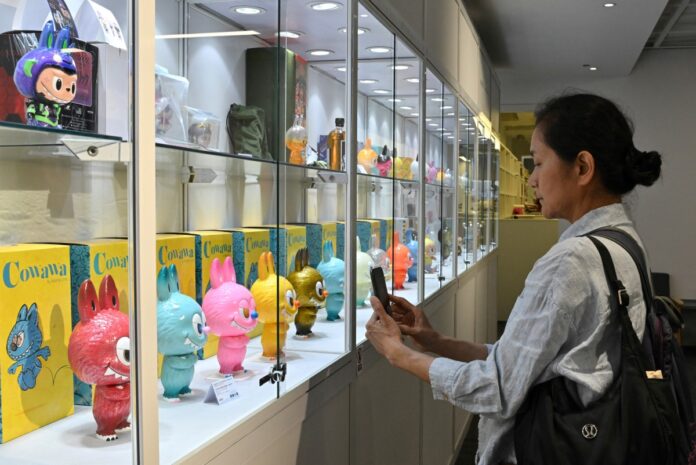Tiny, fuzzy, and sporting a mischievous grin with sharp teeth, the Labubu monster dolls from Chinese toymaker Pop Mart have taken the world by storm. These collectible figures are now attracting huge crowds at international stores and even gracing the handbags of celebrities like Rihanna and Cher, marking a new era for Chinese cultural exports.
Based in Beijing, Pop Mart is a prime example of a growing wave of Chinese cultural products that are successfully gaining traction abroad. The adorable yet edgy Labubus are acting as friendly ambassadors, projecting a “cool” image of China, even in regions where public opinion towards Beijing might otherwise be negative.
The Allure of Labubu: Quirky Design and Blind Box Hype

Labubu dolls typically retail for around $40. Their unique appeal is heightened by their release in limited quantities and their sale in “blind boxes”, meaning buyers don’t know the exact design they’ll get until they open it. This element of surprise, combined with their distinctive appearance, fuels immense excitement and collectibility.
As interior designer Lucy Shitova observed at a Pop Mart store in London, where in-person Labubu sales have even been temporarily suspended due to fears of unruly fan behavior, the dolls are “a bit quirky and ugly and very inclusive, so people can relate.” Their global virality, she noted, is largely thanks to social media, making them feel “cool” and “different.”
Shifting Perceptions: China as a “Brand-Creating Nation”
Historically, China’s cultural exports have faced challenges. While East Asian neighbors like South Korea and Japan are globally recognized for their high-end fashion, cinema, and pop music, China’s heavily regulated film and music industries have struggled to capture international audiences. Its most widely known clothing exporter has been the fast-fashion giant Shein. Moreover, Chinese companies selling upmarket goods under their own brands have often battled stereotypes of cheap and low-quality products.
“It has been hard for the world’s consumers to perceive China as a brand-creating nation,” noted Fan Yang of the University of Maryland. However, Pop Mart, with its runaway success, is effectively bucking this trend. The popularity of Labubu has even led to unofficial copycats, dubbed “lafufus” by social media users, and a proliferation of detailed YouTube videos guiding collectors on how to verify a doll’s authenticity.
Beyond Pop Mart, other Chinese brands are also gaining international recognition. Designer womenswear label Shushu/Tong, Shanghai-based Marchen, and Beijing-based handbag maker Songmont are all making their mark in global markets, signaling a broader shift in perception.
The TikTok Factor: Soft Power and Global Image
Analysts like Allison Malmsten from China-based Daxue Consulting suggest that viral exports such as Labubu are contributing to a “soft-power shift” for China, where its products and image are increasingly seen as appealing among young Western audiences. Malmsten draws a parallel to Japan’s cultural influence from the 1980s to the 2010s, driven by phenomena like Pokémon and Nintendo.
The crucial conduit for Labubu’s global rise is the video app TikTok. Developed by China’s ByteDance, TikTok became the first Chinese-branded product to achieve indispensable status among young people worldwide. Joshua Kurlantzick of the Council on Foreign Relations (CFR) believes TikTok “probably played a role in changing consumers’ minds about China.” Despite being officially blocked within China (though accessible via VPNs), TikTok boasts over one billion users globally, including nearly half of the U.S. population. The app, which has faced national security concerns in the United States (leading some users to migrate to another Chinese app, Rednote), hosts over 1.7 million videos specifically about Labubu, demonstrating its immense power in driving cultural trends and shaping perceptions.
Through the unexpected global embrace of quirky characters like Labubu and the pervasive reach of platforms like TikTok, China is subtly reshaping its cultural narrative on the international stage, proving that “cool” can indeed be made in China.


